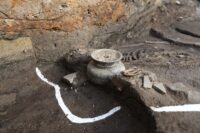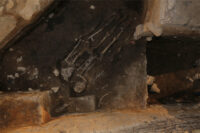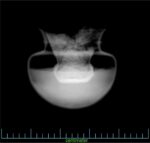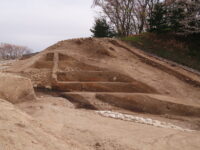 The skeletal remains of a woman have been found under the west walls of the Wolseong Palace site in Gyeongju, South Korea, not 20 inches away from where the bones of a man and woman were discovered in 2017. The young woman’s burial dates to the 4th century and she may have been interred there as part of a foundation sacrifice.
The skeletal remains of a woman have been found under the west walls of the Wolseong Palace site in Gyeongju, South Korea, not 20 inches away from where the bones of a man and woman were discovered in 2017. The young woman’s burial dates to the 4th century and she may have been interred there as part of a foundation sacrifice.
When the remains of the two bodies were discovered, some raised the possibility that their deaths could have been accidental. But, the Cultural Heritage Administration concluded that the evidence — the remains showing no signs of struggle and the discoveries of animal bones and objects used for ancestral rites in the same area — clearly points that the pair died as part of a sacrificial ceremony.
“Now with the additional discovery, there’s no denying Silla’s practice of human sacrifice,” said Choi Byung-heon, professor emeritus of archaeology at Soongsil University, adding that the specific location of where the remains were discovered is also important.
According to Choi, the remains of three Silla people were laid on top of the bottommost layer of the fortress’s west wall, right in front of where the west gate would have been located.
“After finishing off the foundation and moving onto the next step of building the fortress, I guess it was necessary to really harden the ground for the fortress to stand strong. In that process, I think the Silla people held sacrificial rites, giving not only animals but also humans as sacrifices,” said Choi.
When the skeleton was found in April of this year, archaeologists first thought it was a child due its diminutive stature (135 cm, or 4’5″). Upon further examination, she was confirmed to be a young adult around 20 years old when she died. Isotope analysis of her teeth found she had  suffered from chronic malnutrition which likely stunted her growth. The couple unearthed in 2017 were older in age but younger in date — around 50 years old when they died in the 5th century. They were also small in stature and had suffered extended nutritional deficiencies. This suggests all three of the deceased buried under the west wall were of low social rank.
suffered from chronic malnutrition which likely stunted her growth. The couple unearthed in 2017 were older in age but younger in date — around 50 years old when they died in the 5th century. They were also small in stature and had suffered extended nutritional deficiencies. This suggests all three of the deceased buried under the west wall were of low social rank.
 An intact pot was found near her head. It was X-rayed and found to contain a second vessel, a small bowl, inside the neck. Archaeologists believe the larger pot contained a liquid, perhaps alcohol. Similar pots were found at the feet of the couple. These are not the typical grave goods found in Silla burials from this period, which underscores that these were not typical burials.
An intact pot was found near her head. It was X-rayed and found to contain a second vessel, a small bowl, inside the neck. Archaeologists believe the larger pot contained a liquid, perhaps alcohol. Similar pots were found at the feet of the couple. These are not the typical grave goods found in Silla burials from this period, which underscores that these were not typical burials.
Wolseong was the primary residence of Silla kings in Gyeongju, the kingdom’s capital city, until the fall of the Silla Dynasty in 935. According to  a 12th century Korean history, Wolseong was built as a royal fortress by King Pasa in 101 A.D., but no archaeological evidence has been found to confirm so early an origin. Indeed, Accelerator Mass Spectrometer data narrowed down initial construction to the early 4th century and continuing for about 50 years.
a 12th century Korean history, Wolseong was built as a royal fortress by King Pasa in 101 A.D., but no archaeological evidence has been found to confirm so early an origin. Indeed, Accelerator Mass Spectrometer data narrowed down initial construction to the early 4th century and continuing for about 50 years.